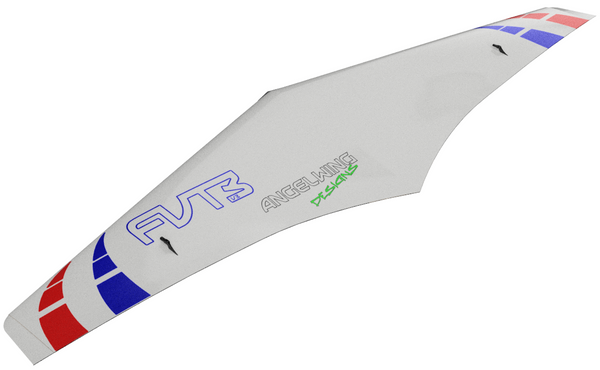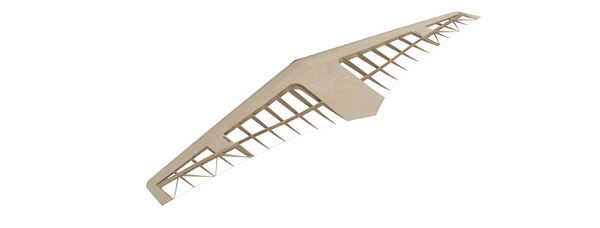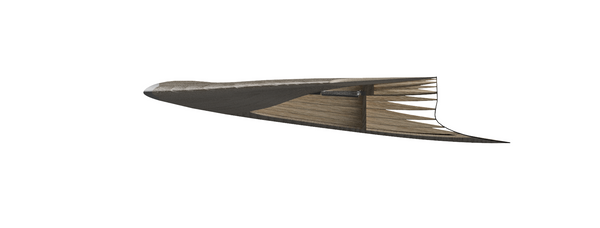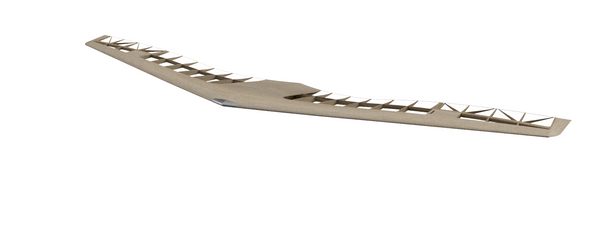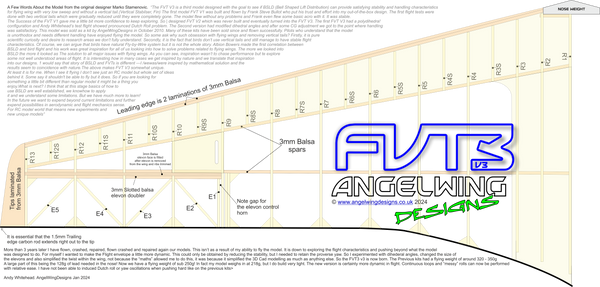FVT3 (v3) Prandtl Wing
1200mm span Unique finless flying wing using Bell Shaped Lift Distribution
Comprehensive Deluxe Kit Contains
- High quality Laser cut balsa parts
- Selected 1.5mm Balsa wing sheet
- Preformed weighted nose block (approx 50g weight)
- Carbon Fibre Rod trailing edge
- 32awg Servo extension wire
- Servo covers and Hatch
- Vinyl Decals (colours may vary)
Download the Instructions HERE
The Original FVT has given us many hours of fun, Bemused looks, comments and banter.
Most people who see these unique wings fly for the first time are amazed by the sheer fact that it does fly. No vertical stabiliser, no wing fences, no gyro, no drag rudders, just a simple set of elevons. When Marko originally conceived the FVT3 the design goal was from an aerodynamics perspective. The goal being to achieve a self stabilising "Nurflugel" all wing aircraft with minimal sweep and a straight trailing edge. This in part as if these ideas were translated to full sized applications it is far easier to build a rigid structure that does not have the traditional sweep of a "Horten" wing. His design goals were met with a very successful flying model which is inherently stable. After many hours of flying the inherent stability would sometimes been a little too stable where over control would induce "Dutch Roll"
So the v3 I had a set of improvements I wanted to make to tune the design with a greater focus on being a simple slope soarer. The key goals being.
- Easier to build
- Sub 250g
- Reduce / eliminate Dutch roll
- Give the RC pilot a more hands on feel
Well these goals have all been achieved. The prototype weighed in a just 228g some 100g lighter than my own previous model. Its easier to build (beware some of the tips ribs are still very small) I have not been able to induce the Dutch Roll and you do have to fly the model more "that hands on feel"
| Span | 1200mm | 47.25 inches |
| Root Section | Proprietary | 8% Thick |
| Tip Section | Propietary | 7.5% Thick |
| Twist | Variable, Non Linear | BSLD |
| Weight | 220 - 250 g | 7.9 to 8.9 oz |
| Wing Area | 19.2 dcm2 | 297 sq in 2.06sq ft |
| Wing Loading | 11.45 - 12.85 g/dcm2 | 3.8 - 4.3 oz/sqft |
| Dihedral | Approx 3 degrees | |
| Elevator throw | 30 degrees up and down | No expo |
| Aileron Throw | 20 degrees up 15 down | 20 to 30% expo |
| CG | 80 to 82mm from LE | CRITICAL! |
As you can see from the data table above the FVT3 (v3) is very lightly loaded. Despite this, due to the thin wing section and low drag it can penetrate well into smooth slope lift. What it doesn’t like however is blustery conditions or turbulence. Turbulence simply tosses the model around. So for test flights pick a day with light winds 5 to 10 mph (2.2 - 4.5 m/s). Launching is simple despite the lack of a “skeg” or anything to grab. Hold the model by the nose with your thumb underneath the nose and you four fingers on the upper surface. Its natural using this method to push the model away in a slightly nose down attitude (exactly what we need). You will quickly notice that the model is amazingly pitch stable. Hence the large elevator throws, but sensitive in roll. Roll inputs should be applied smoothly and progressively. If you have any pronounced “Dutch roll” then your CG is simply too far back. Allow the model to settle naturally and keep the flying speed at its natural happy point. Losing altitude quickly is best done by holding the model in a tight turn with some down elevator in. Applying down elevator only increases the speed of the model but as soon as you back off the application of down elevator it tends to instantly zoom back up to height. Loops are easy after a short dive buy the application of full up elevator and reducing the elevator as you go over the top. Rolls are messy! but possible at speed. The FVT3 was never designed to be aerobatic in any way. Landing is easy you just have to fly the model to touchdown. If you slow the model too much you will not see a conventional stall but will loose directional stability. We hope you have fun exploring this unique flying model.






